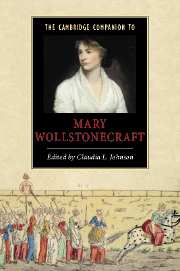Book contents
- Frontmatter
- 1 Introduction
- 2 Mary Wollstonecraft's letters
- 3 Mary Wollstonecraft on education
- 4 Mary Wollstonecraft's Vindications and their political tradition
- 5 Mary Wollstonecraft's French Revolution
- 6 Mary Wollstonecraft's literary reviews
- 7 The religious foundations of Mary Wollstonecraft's feminism
- 8 Mary Wollstonecraft and the literature of advice and instruction
- 9 Mary Wollstonecraft's A Vindication of the Rights of Woman and the women writers of her day
- 10 Mary Wollstonecraft and the poets
- 11 Mary Wollstonecraft's novels
- 12 Letters Written During a Short Residence in Sweden, Norway, and Denmark: traveling with Mary Wollstonecraft
- 13 Mary Wollstonecraft and the sexuality of genius
- 14 Mary Wollstonecraft's reception and legacies
- Select bibliography
- Index
8 - Mary Wollstonecraft and the literature of advice and instruction
Published online by Cambridge University Press: 28 May 2006
- Frontmatter
- 1 Introduction
- 2 Mary Wollstonecraft's letters
- 3 Mary Wollstonecraft on education
- 4 Mary Wollstonecraft's Vindications and their political tradition
- 5 Mary Wollstonecraft's French Revolution
- 6 Mary Wollstonecraft's literary reviews
- 7 The religious foundations of Mary Wollstonecraft's feminism
- 8 Mary Wollstonecraft and the literature of advice and instruction
- 9 Mary Wollstonecraft's A Vindication of the Rights of Woman and the women writers of her day
- 10 Mary Wollstonecraft and the poets
- 11 Mary Wollstonecraft's novels
- 12 Letters Written During a Short Residence in Sweden, Norway, and Denmark: traveling with Mary Wollstonecraft
- 13 Mary Wollstonecraft and the sexuality of genius
- 14 Mary Wollstonecraft's reception and legacies
- Select bibliography
- Index
Summary
In 1789, Wollstonecraft included extracts from John Gregory's A Father's Legacy to his Daughters, one of the most popular of eighteenth-century conduct books, in her anthology The Female Reader; in 1792, in A Vindication of the Rights of Woman, she claimed to “entirely disapprove of his celebrated Legacy,” and Gregory was among those singled out as “writers who have rendered women objects of pity.” On the face of it, this looks like a radical change of opinion: a clear symptom of a newly politicized Wollstonecraft explicitly rejecting the kind of advice literature which she had been prepared to reproduce, and even to emulate, as a struggling freelance writer in the late 1780s but which, in the revolutionary atmosphere of the early 1790s, she recognized as one of those repressive cultural mechanisms responsible for turning women into mere “creatures of sensation” (VRW:130). But to read this as a straightforward volt face on Wollstonecraft's part would be far too simple an account of her view of Gregory, or of the wider tradition of female conduct literature which his text represents. Furthermore, it would be a serious misunderstanding of Wollstonecraft's relationship with the multifarious genre of advice writing more generally. As an autodidact, and then as an independent woman trying to make a living from her writing, Wollstonecraft relied throughout her life on those instructional genres through which moral principles and enlightenment knowledges were offered up to a popular audience. Her first publication, Thoughts on the Education of Daughters (1787), was a kind of conduct book, and Rights of Woman itself still bears a more than passing resemblance to the genre. In each case, advice on “improvement” is a primary characteristic, and the moral agenda which underpins this urge to (self-)improvement means that distinctions between attaining proper standards of personal “conduct,” defining oneself as a virtuous domestic woman, aspiring to an appropriate education, and simply expanding one's knowledge, can become blurred: for modern readers, often uncomfortably so.
- Type
- Chapter
- Information
- The Cambridge Companion to Mary Wollstonecraft , pp. 119 - 140Publisher: Cambridge University PressPrint publication year: 2002
- 7
- Cited by

